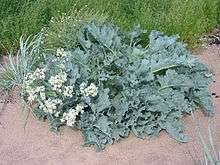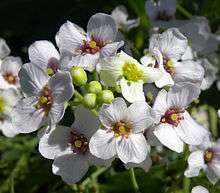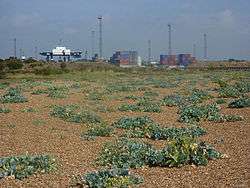Crambe maritima
| Sea kale | |
|---|---|
 | |
| Sea kale growing in Estonia | |
| Scientific classification | |
| Kingdom: | Plantae |
| (unranked): | Angiosperms |
| (unranked): | Eudicots |
| (unranked): | Rosids |
| Order: | Brassicales |
| Family: | Brassicaceae |
| Genus: | Crambe |
| Species: | C. maritima |
| Binomial name | |
| Crambe maritima L. | |


Crambe maritima (common name sea kale, seakale or crambe[1]) is a species of halophytic flowering plant in the genus Crambe of the family Brassicaceae (Cruciferae),[2] that grows wild along the coasts of Europe, from the North Atlantic to the Black Sea.
Description
Growing to 75 cm (30 in) tall by 60 cm (24 in) wide, it is a mound-forming, spreading perennial.[3] It has large fleshy glaucous collard-like leaves and abundant white flowers. The seeds come one each in globular pods.
Distribution
Very rare in Northern Ireland, recorded from Counties Down and Antrim[4] and from a number of seaside counties of Ireland.[5]
It is found scarcely through the coast of Norway, particularly in Færder National Park. [6]
Culinary use
The plant is cultivated as a vegetable, related to the cabbage.
Along the coast of England, where it is commonly found above high tide mark on shingle beaches, local people heaped loose shingle around the naturally occurring root crowns in springtime, thus blanching the emerging shoots. By the early eighteenth century, it had become established as a garden vegetable, but its height of popularity was the early nineteenth century when sea kale appeared in Thomas Jefferson's Garden Book of 1809. It was also served at the Royal Pavilion in Brighton, when Prince Regent George IV of the United Kingdom (1762–1830) used it as a seaside retreat.
The shoots are served like asparagus: steamed, with either a béchamel sauce or melted butter, salt and pepper. It is apt to get bruised or damaged in transport and should be eaten very soon after cutting, this may explain its subsequent decline in popularity. However, given a rich, deep and sandy soil, it is easy to propagate and grow on from root cuttings available from specialist nurseries. Blanching may be achieved by covering it with opaque material or using a deep, loose and dry mulch.[7]
As an ornamental plant
As an ornamental garden plant, C. maritima has gained the Royal Horticultural Society's Award of Garden Merit.[8]
References
- ↑
 Gilman, D. C.; Thurston, H. T.; Colby, F. M., eds. (1905). "Sea-kale". New International Encyclopedia (1st ed.). New York: Dodd, Mead.
Gilman, D. C.; Thurston, H. T.; Colby, F. M., eds. (1905). "Sea-kale". New International Encyclopedia (1st ed.). New York: Dodd, Mead. - ↑ Webb, D.A., Parnell, J. and Doogue, D. 1996. An Irish Flora. Dundalgan Press Ltd, Dundalk ISBN 0-85221-131-7
- ↑ RHS A-Z encyclopedia of garden plants. United Kingdom: Dorling Kindersley. 2008. p. 1136. ISBN 1405332964.
- ↑ Hackney, P. 1992. Stewart' and Corry's Flora of the North-east of Ireland. Third edition. Institute of Irish Studies and Queen's University of Belfast. ISBN 0 85389 446 9 (HB)
- ↑ Scannell, M.J.P. and Synnott, D.M. 1972. Census Catalogue of the Flora of Ireland. Dublin, Published by the Stationary Office
- ↑ http://www.nrk.no/vestfold/viltvoksende-oy-vekster-kan-lose-matproblemer-1.12789571 (in Norwegian, retrieved 15.02.16)
- ↑ "Crambe maritima". Retrieved 7 July 2013.
- ↑ "RHS Plant Selector - Crambe maritima". Retrieved 7 July 2013.
| Wikimedia Commons has media related to Crambe maritima. |